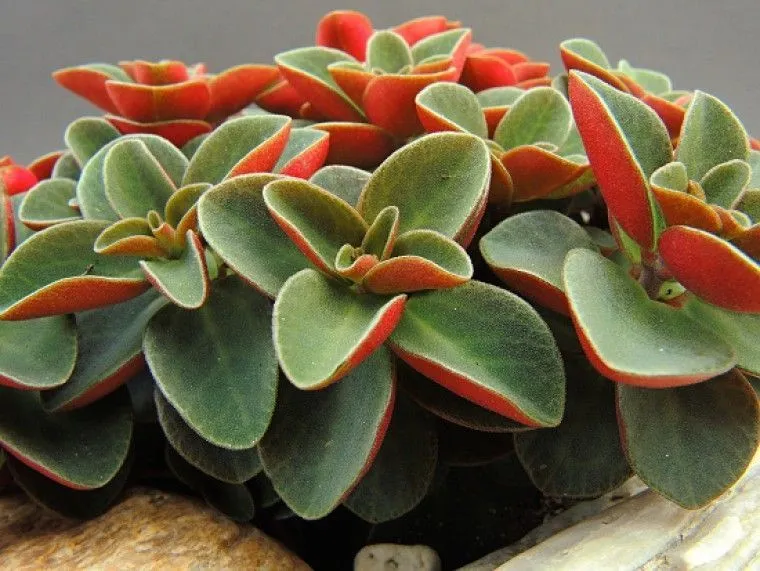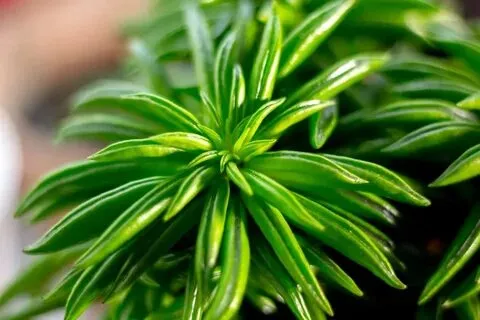Peperomia Happy Bean, scientifically known as Peperomia ferreyrae, is a charming and easy-to-care-for houseplant that has captured the hearts of indoor gardeners worldwide. With its succulent-like leaves shaped like beans, this plant adds a unique aesthetic to any space. The vibrant green leaves, often tipped with a translucent window. it’s a non-toxic plant, safe for households with pets and children, adding to its popularity among home gardeners. Peperomia Happy Bean is native to the tropical regions of South America, particularly in the rainforests of Peru. These regions are characterized by high humidity and moderate temperatures, which provide the perfect environment for Peperomia species to thrive. In their natural habitat, these plants grow under the canopy of large trees, enjoying dappled sunlight and moist, well-draining soil. When deciding where to place your Peperomia Happy Bean, consider its natural habitat. While it can technically be grown outdoors in tropical climates, it is primarily an indoor plant in most regions. Indoors, it thrives in bright, indirect light. A spot near an east or west-facing window is ideal, where it can receive ample light without being scorched by the sun's direct rays. The key to a healthy Peperomia Happy Bean lies in the soil. This plant prefers well-draining soil that mimics its natural rainforest floor environment. A mix of peat moss, perlite, and potting soil creates the perfect balance, ensuring the roots have enough aeration and do not sit in water, which could lead to root rot. Adding some sand or orchid bark to the mix can further improve drainage. Planting Peperomia Happy Bean is a straightforward process. Start by selecting a small pot with drainage holes. Fill the pot halfway with the prepared soil mix. Place the plant in the center, spreading out the roots gently. Fill in around the roots with more soil, pressing lightly to secure the plant. Water thoroughly, allowing the excess water to drain out. I’ve found that giving the plant a good initial soak helps it settle into its new home. You May Also Like: How to Grow and Care for Peperomia Emerald Ripple Peperomia Happy Bean thrives in bright, indirect light. While it can tolerate lower light conditions, insufficient light may cause the plant to become leggy and lose its vibrant green color. In my experience, placing the plant near an east-facing window provides the perfect balance of light. If natural light is insufficient, consider using a grow light to supplement. The best soil for Peperomia Happy Bean is one that offers excellent drainage while retaining some moisture. A combination of potting soil, perlite, and peat moss works well. Personally, I like to add a handful of orchid bark to the mix, which not only improves drainage but also adds a bit of organic matter that the plant seems to love. Peperomia Happy Bean prefers to be kept on the drier side. Water the plant thoroughly when the top inch of soil feels dry to the touch. During the growing season, I water mine about once a week, but I reduce this frequency in the winter when the plant’s growth slows down. Overwatering is the most common mistake, so it’s better to err on the side of caution. Peperomia Happy Bean thrives in temperatures between 65°F and 80°F, which makes it perfect for indoor environments. It also appreciates moderate humidity but can tolerate lower levels. I’ve noticed that during dry winter months, placing the plant near a humidifier or on a pebble tray helps maintain its health and vibrancy. Fertilizing Peperomia Happy Bean regularly during the growing season encourages healthy growth. A balanced, water-soluble fertilizer diluted to half strength works best. I feed mine once a month from spring through summer. During the fall and winter, I reduce feeding to once every two months, as the plant’s growth naturally slows down. Pruning is not a major requirement for Peperomia Happy Bean, but occasional trimming can help maintain its shape and encourage bushier growth. I usually prune mine in the spring, removing any leggy or damaged stems. This not only improves the plant’s appearance but also redirects its energy to healthier growth. Peperomia Happy Bean is unique in itself, but there are a few variations and related species that are also popular among plant enthusiasts. Some noteworthy varieties include: When choosing a pot for your Peperomia Happy Bean, opt for a small to medium-sized container with drainage holes. Terracotta pots are an excellent choice as they allow the soil to dry out more quickly, reducing the risk of overwatering. However, plastic pots can also work well as long as you are mindful of your watering habits. Peperomia Happy Bean does not require frequent repotting, as it prefers to be somewhat root-bound. I usually repot mine every two to three years, or when I notice the roots are starting to outgrow the pot. To repot, gently remove the plant from its current pot, shake off the excess soil, and place it in a new pot with fresh soil. Be careful not to damage the roots during this process. After repotting, water the plant lightly and place it in a spot with indirect light to help it acclimate to its new home. Like most houseplants, Peperomia Happy Bean can be susceptible to pests such as spider mites, mealybugs, and aphids. These pests often hide under the leaves or in the crevices of the plant. Spider mites appear as tiny red or yellow spots, mealybugs look like small cotton balls, and aphids are small green or black insects that can be found in clusters. Peperomia Happy Bean is relatively disease-resistant, but it can occasionally fall victim to fungal infections like root rot, particularly if overwatered. Symptoms of root rot include yellowing leaves, a soft stem base, and a foul smell emanating from the soil. Another common issue is leaf spot, caused by bacterial or fungal pathogens, which appears as brown or black spots on the leaves. To treat pests, a gentle insecticidal soap or neem oil can be effective. For mealybugs, you can also use a cotton swab dipped in rubbing alcohol to remove them. Preventive measures include regularly inspecting your plant, maintaining proper humidity levels, and ensuring good air circulation. To prevent diseases, avoid overwatering, and make sure your plant is in well-draining soil. If root rot is suspected, repot the plant into fresh soil, removing any affected roots. Yellowing leaves can be a sign of overwatering, underwatering, or nutrient deficiency. Check the soil moisture and adjust your watering schedule accordingly. If the issue persists, try feeding the plant with a balanced fertilizer to replenish any missing nutrients. Stunted growth in Peperomia Happy Bean is often caused by low light or poor soil conditions. Ensure that your plant is getting enough indirect light and that it’s planted in a well-draining soil mix. Repotting the plant into fresh soil can also help rejuvenate its growth. Fungal infections are typically the result of overwatering or poor air circulation. If you notice signs of fungal infection, such as black spots or moldy soil, reduce watering and increase ventilation around the plant. Remove any affected leaves and treat the plant with a fungicide if necessary. Spring and summer are the peak growing seasons for Peperomia Happy Bean. During these months, ensure your plant is receiving adequate light and water. Increase your fertilizing schedule to once a month and consider moving the plant to a slightly brighter spot to encourage robust growth. In fall and winter, Peperomia Happy Bean’s growth will slow down. During these cooler months, reduce watering and stop fertilizing to avoid overloading the plant with nutrients it doesn’t need. Keep the plant in a warm spot, away from drafts, and maintain moderate humidity to prevent the leaves from drying out. Peperomia Happy Bean is a delightful and easy-to-care-for houseplant that can thrive in a variety of indoor conditions. With its unique foliage and low-maintenance requirements, it’s no wonder this plant has become a favorite among indoor gardeners. By understanding its needs and providing the right care, you can enjoy a healthy and vibrant Peperomia Happy Bean for years to come. Whether you’re a seasoned plant parent or just starting your indoor garden, this plant is sure to bring joy and greenery into your home.How To Grow And Care Peperomia Happy Bean Easily At Home
2. Understanding Peperomia Happy Bean
Origin and Natural Habitat
3. Planting Peperomia Happy Bean
Choosing the Right Spot: Indoors vs. Outdoors
Soil Preparation: Importance of Well-Draining Soil
Planting Steps: Step-by-Step Guide
4. Peperomia Happy Bean Care
Light
Best Soil Mix
Water
Temperature and Humidity
Fertilizer
Pruning
5. Popular Varieties of Peperomia Happy Bean
6. Propagating Peperomia Happy Bean
Method 1: Stem Cuttings
Method 2: Leaf Cuttings
7. Potting and Repotting Peperomia Happy Bean
Choosing the Right Pot: Best Types of Pots
Repotting Steps
8. Common Pests & Plant Diseases
Common Pests and How to Identify Them
Disease Identification
Treatment and Prevention
9. Troubleshooting Common Problems
Yellowing Leaves
Stunted Growth
Fungal Infections
10. Seasonal Care Tips
Spring and Summer
Fall and Winter
11. Conclusion
Grow And Care Peperomia Happy Bean Easily At Home
| Name | |
|---|---|
| Publisher | |
| Genre | Peperomia |
| Version | |
| Update | August 22, 2024 |
| Get it On |

|









